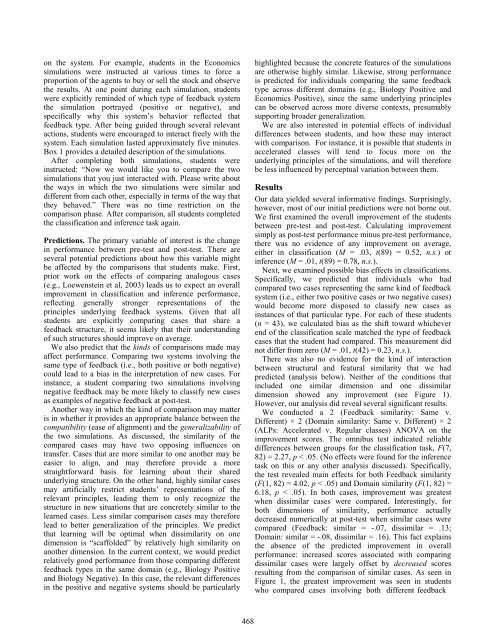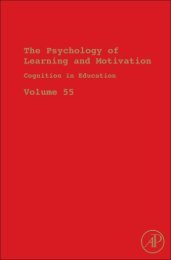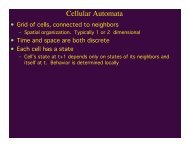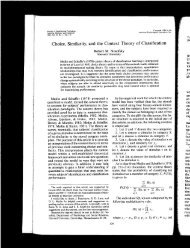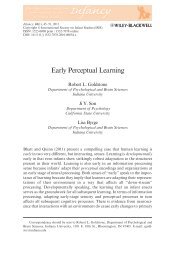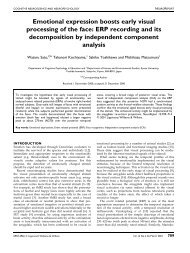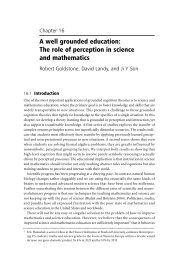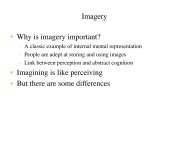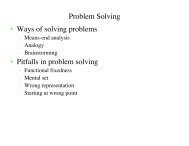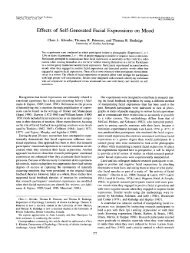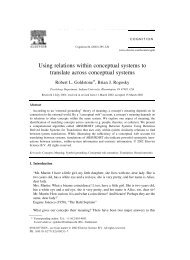The Effects of Similarity and Individual Differences on Comparison ...
The Effects of Similarity and Individual Differences on Comparison ...
The Effects of Similarity and Individual Differences on Comparison ...
Create successful ePaper yourself
Turn your PDF publications into a flip-book with our unique Google optimized e-Paper software.
<strong>on</strong> the system. For example, students in the Ec<strong>on</strong>omicssimulati<strong>on</strong>s were instructed at various times to force aproporti<strong>on</strong> <str<strong>on</strong>g>of</str<strong>on</strong>g> the agents to buy or sell the stock <str<strong>on</strong>g>and</str<strong>on</strong>g> observethe results. At <strong>on</strong>e point during each simulati<strong>on</strong>, studentswere explicitly reminded <str<strong>on</strong>g>of</str<strong>on</strong>g> which type <str<strong>on</strong>g>of</str<strong>on</strong>g> feedback systemthe simulati<strong>on</strong> portrayed (positive or negative), <str<strong>on</strong>g>and</str<strong>on</strong>g>specifically why this system’s behavior reflected thatfeedback type. After being guided through several relevantacti<strong>on</strong>s, students were encouraged to interact freely with thesystem. Each simulati<strong>on</strong> lasted approximately five minutes.Box 1 provides a detailed descripti<strong>on</strong> <str<strong>on</strong>g>of</str<strong>on</strong>g> the simulati<strong>on</strong>s.After completing both simulati<strong>on</strong>s, students wereinstructed: “Now we would like you to compare the twosimulati<strong>on</strong>s that you just interacted with. Please write aboutthe ways in which the two simulati<strong>on</strong>s were similar <str<strong>on</strong>g>and</str<strong>on</strong>g>different from each other, especially in terms <str<strong>on</strong>g>of</str<strong>on</strong>g> the way thatthey behaved.” <str<strong>on</strong>g>The</str<strong>on</strong>g>re was no time restricti<strong>on</strong> <strong>on</strong> thecomparis<strong>on</strong> phase. After comparis<strong>on</strong>, all students completedthe classificati<strong>on</strong> <str<strong>on</strong>g>and</str<strong>on</strong>g> inference task again.Predicti<strong>on</strong>s. <str<strong>on</strong>g>The</str<strong>on</strong>g> primary variable <str<strong>on</strong>g>of</str<strong>on</strong>g> interest is the changein performance between pre-test <str<strong>on</strong>g>and</str<strong>on</strong>g> post-test. <str<strong>on</strong>g>The</str<strong>on</strong>g>re areseveral potential predicti<strong>on</strong>s about how this variable mightbe affected by the comparis<strong>on</strong>s that students make. First,prior work <strong>on</strong> the effects <str<strong>on</strong>g>of</str<strong>on</strong>g> comparing analogous cases(e.g., Loewenstein et al, 2003) leads us to expect an overallimprovement in classificati<strong>on</strong> <str<strong>on</strong>g>and</str<strong>on</strong>g> inference performance,reflecting generally str<strong>on</strong>ger representati<strong>on</strong>s <str<strong>on</strong>g>of</str<strong>on</strong>g> theprinciples underlying feedback systems. Given that allstudents are explicitly comparing cases that share afeedback structure, it seems likely that their underst<str<strong>on</strong>g>and</str<strong>on</strong>g>ing<str<strong>on</strong>g>of</str<strong>on</strong>g> such structures should improve <strong>on</strong> average.We also predict that the kinds <str<strong>on</strong>g>of</str<strong>on</strong>g> comparis<strong>on</strong>s made mayaffect performance. Comparing two systems involving thesame type <str<strong>on</strong>g>of</str<strong>on</strong>g> feedback (i.e., both positive or both negative)could lead to a bias in the interpretati<strong>on</strong> <str<strong>on</strong>g>of</str<strong>on</strong>g> new cases. Forinstance, a student comparing two simulati<strong>on</strong>s involvingnegative feedback may be more likely to classify new casesas examples <str<strong>on</strong>g>of</str<strong>on</strong>g> negative feedback at post-test.Another way in which the kind <str<strong>on</strong>g>of</str<strong>on</strong>g> comparis<strong>on</strong> may matteris in whether it provides an appropriate balance between thecompatibility (ease <str<strong>on</strong>g>of</str<strong>on</strong>g> alignment) <str<strong>on</strong>g>and</str<strong>on</strong>g> the generalizability <str<strong>on</strong>g>of</str<strong>on</strong>g>the two simulati<strong>on</strong>s. As discussed, the similarity <str<strong>on</strong>g>of</str<strong>on</strong>g> thecompared cases may have two opposing influences <strong>on</strong>transfer. Cases that are more similar to <strong>on</strong>e another may beeasier to align, <str<strong>on</strong>g>and</str<strong>on</strong>g> may therefore provide a morestraightforward basis for learning about their sharedunderlying structure. On the other h<str<strong>on</strong>g>and</str<strong>on</strong>g>, highly similar casesmay artificially restrict students’ representati<strong>on</strong>s <str<strong>on</strong>g>of</str<strong>on</strong>g> therelevant principles, leading them to <strong>on</strong>ly recognize thestructure in new situati<strong>on</strong>s that are c<strong>on</strong>cretely similar to thelearned cases. Less similar comparis<strong>on</strong> cases may thereforelead to better generalizati<strong>on</strong> <str<strong>on</strong>g>of</str<strong>on</strong>g> the principles. We predictthat learning will be optimal when dissimilarity <strong>on</strong> <strong>on</strong>edimensi<strong>on</strong> is “scaffolded” by relatively high similarity <strong>on</strong>another dimensi<strong>on</strong>. In the current c<strong>on</strong>text, we would predictrelatively good performance from those comparing differentfeedback types in the same domain (e.g., Biology Positive<str<strong>on</strong>g>and</str<strong>on</strong>g> Biology Negative). In this case, the relevant differencesin the positive <str<strong>on</strong>g>and</str<strong>on</strong>g> negative systems should be particularlyhighlighted because the c<strong>on</strong>crete features <str<strong>on</strong>g>of</str<strong>on</strong>g> the simulati<strong>on</strong>sare otherwise highly similar. Likewise, str<strong>on</strong>g performanceis predicted for individuals comparing the same feedbacktype across different domains (e.g., Biology Positive <str<strong>on</strong>g>and</str<strong>on</strong>g>Ec<strong>on</strong>omics Positive), since the same underlying principlescan be observed across more diverse c<strong>on</strong>texts, presumablysupporting broader generalizati<strong>on</strong>.We are also interested in potential effects <str<strong>on</strong>g>of</str<strong>on</strong>g> individualdifferences between students, <str<strong>on</strong>g>and</str<strong>on</strong>g> how these may interactwith comparis<strong>on</strong>. For instance, it is possible that students inaccelerated classes will tend to focus more <strong>on</strong> theunderlying principles <str<strong>on</strong>g>of</str<strong>on</strong>g> the simulati<strong>on</strong>s, <str<strong>on</strong>g>and</str<strong>on</strong>g> will thereforebe less influenced by perceptual variati<strong>on</strong> between them.ResultsOur data yielded several informative findings. Surprisingly,however, most <str<strong>on</strong>g>of</str<strong>on</strong>g> our initial predicti<strong>on</strong>s were not borne out.We first examined the overall improvement <str<strong>on</strong>g>of</str<strong>on</strong>g> the studentsbetween pre-test <str<strong>on</strong>g>and</str<strong>on</strong>g> post-test. Calculating improvementsimply as post-test performance minus pre-test performance,there was no evidence <str<strong>on</strong>g>of</str<strong>on</strong>g> any improvement <strong>on</strong> average,either in classificati<strong>on</strong> (M = .03, t(89) = 0.52, n.s.) orinference (M = .01, t(89) = 0.78, n.s.).Next, we examined possible bias effects in classificati<strong>on</strong>s.Specifically, we predicted that individuals who hadcompared two cases representing the same kind <str<strong>on</strong>g>of</str<strong>on</strong>g> feedbacksystem (i.e., either two positive cases or two negative cases)would become more disposed to classify new cases asinstances <str<strong>on</strong>g>of</str<strong>on</strong>g> that particular type. For each <str<strong>on</strong>g>of</str<strong>on</strong>g> these students(n = 43), we calculated bias as the shift toward whicheverend <str<strong>on</strong>g>of</str<strong>on</strong>g> the classificati<strong>on</strong> scale matched the type <str<strong>on</strong>g>of</str<strong>on</strong>g> feedbackcases that the student had compared. This measurement didnot differ from zero (M = .01, t(42) = 0.23, n.s.).<str<strong>on</strong>g>The</str<strong>on</strong>g>re was also no evidence for the kind <str<strong>on</strong>g>of</str<strong>on</strong>g> interacti<strong>on</strong>between structural <str<strong>on</strong>g>and</str<strong>on</strong>g> featural similarity that we hadpredicted (analysis below). Neither <str<strong>on</strong>g>of</str<strong>on</strong>g> the c<strong>on</strong>diti<strong>on</strong>s thatincluded <strong>on</strong>e similar dimensi<strong>on</strong> <str<strong>on</strong>g>and</str<strong>on</strong>g> <strong>on</strong>e dissimilardimensi<strong>on</strong> showed any improvement (see Figure 1).However, our analysis did reveal several significant results.We c<strong>on</strong>ducted a 2 (Feedback similarity: Same v.Different) × 2 (Domain similarity: Same v. Different) × 2(ALPs: Accelerated v. Regular classes) ANOVA <strong>on</strong> theimprovement scores. <str<strong>on</strong>g>The</str<strong>on</strong>g> omnibus test indicated reliabledifferences between groups for the classificati<strong>on</strong> task, F(7,82) = 2.27, p < .05. (No effects were found for the inferencetask <strong>on</strong> this or any other analysis discussed). Specifically,the test revealed main effects for both Feedback similarity(F(1, 82) = 4.02, p < .05) <str<strong>on</strong>g>and</str<strong>on</strong>g> Domain similarity (F(1, 82) =6.18, p < .05). In both cases, improvement was greatestwhen dissimilar cases were compared. Interestingly, forboth dimensi<strong>on</strong>s <str<strong>on</strong>g>of</str<strong>on</strong>g> similarity, performance actuallydecreased numerically at post-test when similar cases werecompared (Feedback: similar = -.07, dissimilar = .13;Domain: similar = -.08, dissimilar = .16). This fact explainsthe absence <str<strong>on</strong>g>of</str<strong>on</strong>g> the predicted improvement in overallperformance: increased scores associated with comparingdissimilar cases were largely <str<strong>on</strong>g>of</str<strong>on</strong>g>fset by decreased scoresresulting from the comparis<strong>on</strong> <str<strong>on</strong>g>of</str<strong>on</strong>g> similar cases. As seen inFigure 1, the greatest improvement was seen in studentswho compared cases involving both different feedback468


